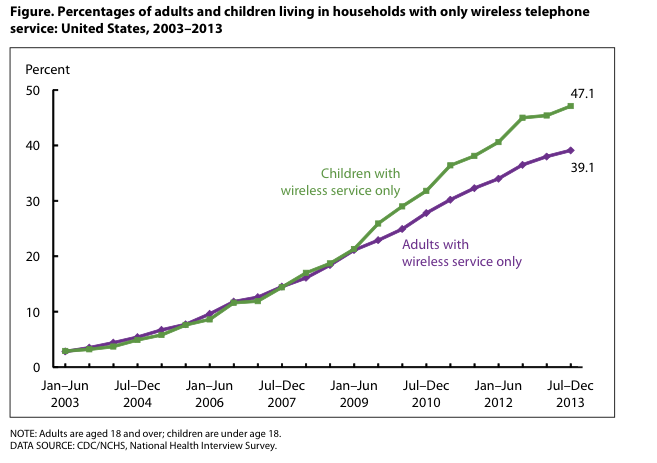41% Of U.S. Homes Are Now Wireless-Only
 Ten years ago, only about 1-in-20 American homes were cellphone-only. By 2010, that rate had soared to 1-in-5. And according to the newest data from the Centers for Disease Control and Prevention, the percentage of U.S. homes that have ditched landlines completely has doubled since 2010, and now stands at 41%.
Ten years ago, only about 1-in-20 American homes were cellphone-only. By 2010, that rate had soared to 1-in-5. And according to the newest data from the Centers for Disease Control and Prevention, the percentage of U.S. homes that have ditched landlines completely has doubled since 2010, and now stands at 41%.
The latest report from the CDC also highlights the difference in generational attitudes toward landlines, with 65.7% of adults between the ages of 25-29 being wireless-only, while only 31.4% of those aged 45-64 have given up landlines, and a mere 13.6% of people over the age of 65 having no landline service.
Interestingly, that 25-29 age group is sandwiched between two age groups with lower rates of wireless-only living. On the younger side, the 18-24 year-olds have a 53% rate of living landline-free. This is likely because some in this demographic either live in college dormitories with built-in landlines or still live with their parents who have yet to abandon their wired ways.
The slightly older 30-34 age group still has a high level of being wireless only, at 59.7%, but why the drop-off from the high level seen in the 25-29 group? This may be due to some members of the older group beginning to settle down, starting families and/or buying homes. The CDC data also shows that 76.1% of people living with unrelated roommates are wireless-only, while only 46.6% of adults who live alone are without landlines. Likewise, the wireless-only rate for renters (61.7%) is significantly higher than it is for homeowners (28.5%). This would seem to indicate that as those 25-29 year-olds grow up, some are choosing to get landlines.
And even though wireless-only homes are still not the majority, the CDC data confirms that the majority of the country now use wireless as their primary phone service.
Since 2010, the CDC survey has asked about “wireless-mostly” homes, those where people receive most or all of their calls on cellphones, even though they have a landline. In the latest report, that number now stands at 18.3% of all U.S. adults. When added to the 41% of adults who don’t have landlines, this means that nearly 3-in-5 American adults has stopped using landline service.
While the wireless-only numbers continue to grow, the CDC notices that they aren’t growing as rapidly as they have in the past.
So why does the CDC worry about whether or not you have landline service? Because it conducts a large number of phone-related surveys on health-related issues and needs to know that the people it speaks to for these surveys represent the population at large. If they were to only call people who use landlines, their results may be biased toward older homeowners and may not account for large portions of the population.
Want more consumer news? Visit our parent organization, Consumer Reports, for the latest on scams, recalls, and other consumer issues.

